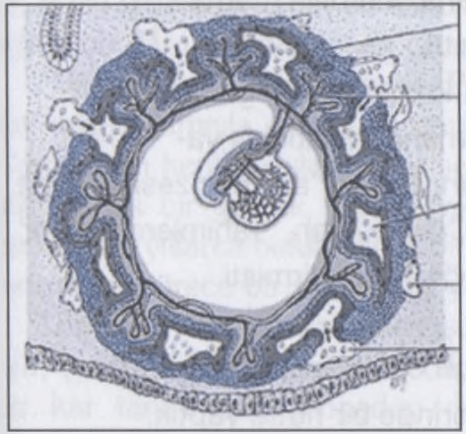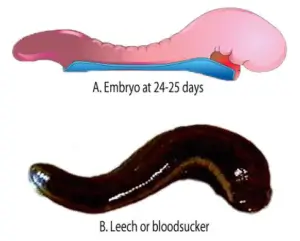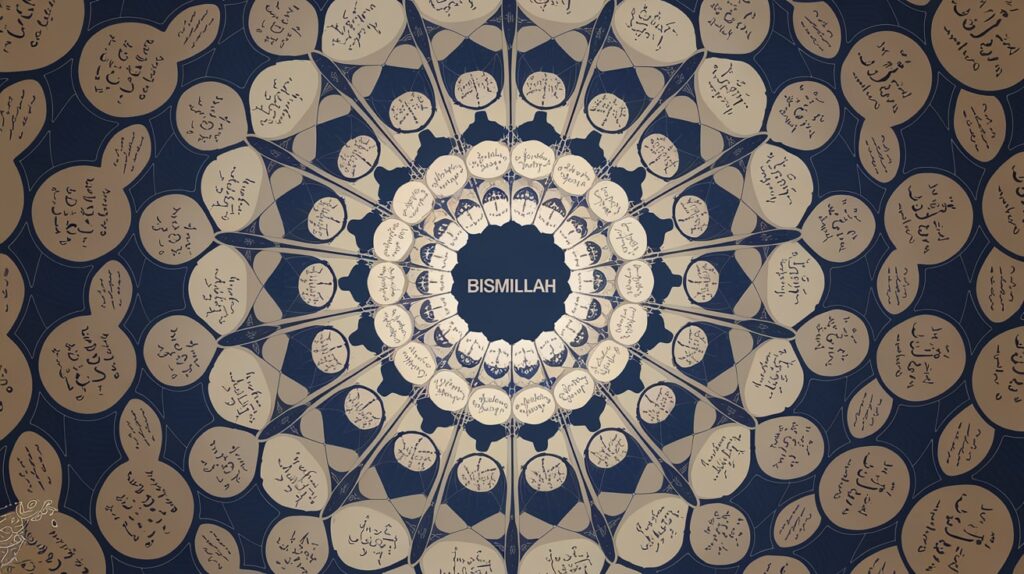Allah the Creator of human beings talks in his last revelation, the Quran about the embryo stages. Multiple times in different chapters of the Quran we get to read verses about the development of embryo, each time revealing more information. He talks about the stages of development and gives us a clear picture of what the embryo looks like in these stages. In this article we will have a closer look at these verses and compare it to the latest science on the subject.
Lets´s look at these verses first and extract all the information we can find about the embryo.
Verses of the Quran about Embryo Stages
He created you (all) from a single Person: then created, of like nature, his mate; and he sent down for you eight head of cattle in pairs: He makes you, in the wombs of your mothers, in stages, one after another, in three veils of darkness. such is Allah, your Lord and Cherisher: to Him belongs (all) dominion. There is no god but He: then how are ye turned away (from your true Centre)?
Qur'an 39:6
In this verse we see that Allah clearly says that He creates us in stages, one after another in three veils of darkness. We’ll take a closer look at the expression “three veils of darkness” later. Lets jump to the next verse.
O mankind! if ye have a doubt about the Resurrection, (consider) that We created you out of dust, then out of sperm, then out of a leech-like clot (alaqah), then out of a morsel of flesh (mudghah), partly formed and partly unformed, in order that We may manifest (our power) to you; and We cause whom We will to rest in the wombs for an appointed term, then do We bring you out as babes, then (foster you) that ye may reach your age of full strength; and some of you are called to die, and some are sent back to the feeblest old age, so that they know nothing after having known (much). And (further), thou seest the earth barren and lifeless, but when We pour down rain on it, it is stirred (to life), it swells, and it puts forth every kind of beautiful growth (in pairs).
Qur'an 22:5
In this verse we are introduced to some new words that we´ll inspect later such as “alaqah” and “mudghah”. The next and the last verse that we´ll look at is from chapter 23.
Then We made the sperm into a clot of congealed blood (alaqah: clot of blood or leech) ; then of that clot We made a (foetus) lump (mudghah: chewed like substance/piece of meat); then we made out of that lump bones and clothed the bones with flesh; then we developed out of it another creature. So blessed be Allah, the best to create!
Qur'an 23:14
What a descriptive verse that is. We see once again thos two words “alaqah” and “mudghah” from the previous verse. Now let´s summarize all the information in order to have an overview.
Overview
Quran: 39:6
- created in stages, one after another
- in three veils of darkness
Quran: 22:5
- created out of dust
- then out of sperm
- then out of “alaqah”
- then out of “mudghah”, which is partly formed and partly unformed
Quran: 23:14
- created out of sperm
- turned it into “alaqah”
- turned it into “mudghah”
- from mudghah, bones were created which were then clothed with flesh
Commentary on Qur'an 39:6
- created in stages, one after another: In chapter 39, verse 6, Allah revealed that the development of the embryo happens in stages one after another. Today in our modern world this is a widely common way to teach the embryo development in schools and universities. One of the most common ways of classifying pregnancy is classifying it in three stages. The “germinal stage”, “embryonic stage” and finally the “fetal stage”. Even within these three stages there are sub-stages, which proves the first information of our list to be true.
- in three veils of darkness: This piece of information could be refering to two scientific facts.
- First one being the three main stages that was mentioned above. The “germinal stage”, “embryonic stage” and the “fetal stage”.
- The second one is more interesting: It could refer to the three veils of darkness, which is describing the physical space that the embryo is located in. These three veils are the abdominal wall, the uterine wall and finally the amniotic sac. These three anatomical layers protect the embryo from external injury and keep it in optimal temperature inside the mothers womb.
Either way the Quran has got it right.
Commentary on Qur'an 22:5
created out of dust: This is a clear indication to the creation of Adam (as).
then out of sperm: very well known fact, no further commentary necessary
then out of “alaqah”: Arabic words are derived from so called root words. For example, the word “alaqah” is derived from the root word “Aa-la-qa.” which means “to cling” or “to suspend.” The specific derivation “alaqah” is used in the Qur’an, and it has a dual meaning: It can mean either “a clump/clot of blood” or “leech.” This can be seen for example in the Arabic-English Dictionary “A Dictionary of Modern Written Arabic” by J. Milton Cowan. On page 634, this word is translated into English as “medicinal leech; leech, blood, blood clot.”
So we end up with three possible translations for alaqah: “suspended”, “blood clot” and “leech”. At first sight there is no apparent commonalities between these three translations but in our case all of these three words are accurate in describing the outer appearance of the early embryo. Let´s see how that´s possible:
- Blood clot: During the 21st or 22nd day of development, the embryo’s heart connects with its blood vessels and forms the cardiovascular system. The heart begins to beat and circulate blood for the first time. This resembles a blood clot.
- Suspended: The connecting stalk, or body stalk also known as the allantoic stalk is a yolk sac diverticulum, that by the third week of development connects the embryo to its shell of trophoblasts. As a result, the embryo clings to the shell of the trophoblast. See picture. Amazingly, embryologists John Allan and Beverley Kramer use the word “suspend” to describe the role of the connecting stalk: “Caviation of the extra-embryonic mesoderm does not occur at the connecting stalk which remains intact to suspend the developing embryo in the extra-embryonic coelom.” [The Fundamentals of Human Embryology. 2nd Edition. Wits University Press. 2010, page 27]

Leech: Comparing the embryo at its 25th day of development (which can not be seen with the naked eye without a microscope) one could see the resemblance to a leech. Professor Dale Layman describes the embryo as worm-like in appearance: “Another membrane becomes the yolk sac, which provides nourishment for the early embryo. By 24 days, a connecting stalk appears in the middle of the now worm-like body.” [Anatomy Demystified.2004, page 366]
Professor Keith Moore states: “The human embryo is truly leech like.”

As you can see, whatever translation we choose for “alaqah”, the Qur’an manages to stay true to modern science by being able to describe the embryo at around 21-25th day from what appear to be three different meanings of one word. See the illustration below:

Continuing our commentary on the verse 22:5:
then out of “mudghah”, which is partly formed and partly unformed: The word “mudghah” is translated as “chewed meat/morsel of flesh”. The embryo at the end of it´s 4th week of development start to grow little arms and legs (arm buds and leg buds). The embryo is now about 5mm long and its most important parts are its heart, which is beating at this point, and its brain, which is starting to form. It also has somites that look like toothmarks as Quran has described it. Looking at the picture below we can easily say that the expression “chewed meat” is very accurate for this stage of the development. The verse also says “partly formed and partly unformed which is also very true, when we consider its brain, arms and legs that just started to form.
Here´s what Professor Keith L. Moore says about this verse: “We learnt what the aforementioned verses mean in astonishment when we examined the embryo of this stage. For, there becomes a string of beads appearance on the embryo on around the 28th day and they identically look like tooth marks in appearance. We made a plastic model of the embryo of this stage and marked with our teeth marks by chewing it. The generated model extremely looked like the embryo of the stage of which we were examining and that explained very well why the Qur’an describes the human embryo as a lump of chewed meat.”

Looking back at this verse of the Quran 22:5 we can see that God explains the first four weeks of embryonic development very accurately.
Commentary on Qur'an 23:14
- created out of sperm: no commentary needed
- turned it into “alaqah”: see above
- turned it into “mudghah”: see above
- from mudghah, bones were created which were then clothed with flesh: This part may or may not create confusion. Some people defend that this verse says that bones were created first then the muscles were created, so the bones can be clothed with those muscles, which would be scientifically not correct. But the truth is as follows:
The word for creation is “khalaqa”, which is used in this verse for the creation of bone. If you look closely in the verse, the verb used for muscle is not “khalaqa”, but “kasawnaa” (meaning: we have covered). The Quran simply doesn’t give information about when the muscle is created. It only talks about the attachment of the muscle to the bone. So the chronology given in the Quran is: Formation of initial lump>formation of bone> attachment of muscle cells into the bone.
Assuming that these words originates from a man from the 7th century in the middle of the Saudi desert would simply be moronic. The Qur’an has managed to describe the embryo quite extensively in very few sentences. This in itself is an miracle. The fact that its description is very clear and accurate no matter how you look at it convinced me withoubt a doubt that this book is from the Creator itself.
Still not convinced?
If you are not convinced by my comments on these verses, here are some comments from biology professors on the Qur’anic description of the embryo.
Keith Leon Moore (5 October 1925 – 25 November 2019) was a professor in the division of anatomy, in the faculty of Surgery, at the University of Toronto, Ontario, Canada. Moore was associate dean for Basic Medical Sciences in the university’s faculty of Medicine and was Chair of Anatomy from 1976 to 1984. He was a founding member of the American Association of Clinical Anatomists (AACA) and was President of the AACA between 1989 and 1991.
“This verse from the Koran states that God made you from a drop and then changed the drop into a leech-like structure which soon changed into a chewed like substance that then took the shape of bone and was clothed with flesh” “I was amazed at the scientific accuracy of these statements which were made in the 7th century A.D”
Dr. Keith Moore
Dr. E. Marshall Johnson is Professor Emeritus of Anatomy and Developmental Biology at Thomas Jefferson University, Philadelphia, Pennsylvania, USA. There, for 22 years he was Professor of Anatomy, the Chairman of the Department of Anatomy, and the Director of the Daniel Baugh Institute. He was also the President of the Teratology Society. He has authored more than 200 publications.
“The Quran describes not only the development of external form, but emphasizes also the internal stages, the stages inside the embryo, of its creation and development, emphasizing major events recognized by contemporary science.” – “As a scientist, I can only deal with things which I can specifically see. I can understand embryology and developmental biology. I can understand the words that are translated to me from the Quran. As I gave the example before, if I were to transpose myself into that era, knowing what I knew today and describing things, I could not describe the things which were described. I see no evidence for the fact to refute the concept that this individual, Muhammad, had to be developing this information from some place. So I see nothing here in conflict with the concept that divine intervention was involved in what he was able to write.”
Dr. E. Marshall Johnson
Dr. Gerald C. Goeringer is Course Director and Associate Professor of Medical Embryology at the Department of Cell Biology, School of Medicine, Georgetown University, Washington, DC, USA. During the Eighth Saudi Medical Conference in Riyadh, Saudi Arabia, Professor Goeringer stated the following in the presentation of his research paper:
“In a relatively few aayahs (Quranic verses) is contained a rather comprehensive description of human development from the time of commingling of the gametes through organogenesis. No such distinct and complete record of human development, such as classification, terminology, and description, existed previously. In most, if not all, instances, this description antedates by many centuries the recording of the various stages of human embryonic and fetal development recorded in the traditional scientific literature.”
Dr. Gerald C. Goeringer
Dr. Maurice Bucaille is an eminent French surgeon, scientist, scholar and author of “THE BIBLE THE QUR’AN AND MODERN SCIENCE”, and “WHAT IS THE ORIGIN OF MAN?” which contains the result of his research into the Judaeo-Christian Revelation and the Qur’an. It is a unique contribution in the field of religion and science.
After a study which lasted ten years, Dr. Maurice Bucaille addressed the French Academy of Medicine in 1976 concerning the existence in the Qur’an of certain statements concerning physiology and reproduction. His reason for doing that was that :
"...our knowledge of these disciplines is such, that it is impossible to explain how a text produced at the time of the Qur'an could have contained ideas that have only been discovered in modern times." "The above observation makes the hypothesis advanced by those who see Muhammad as the author of the Qur'an untenable. How could a man, from being illiterate, become the most important author, in terms of literary merits, in the whole of Arabic literature?”
Dr. Maurice Bucaille







